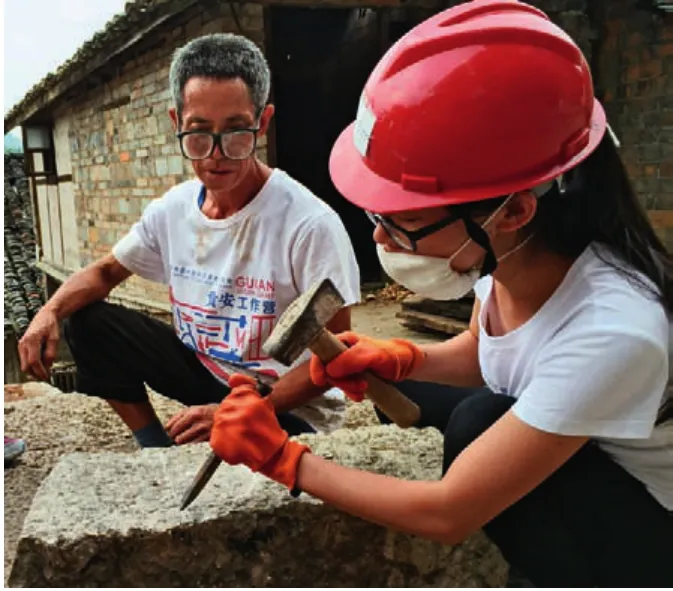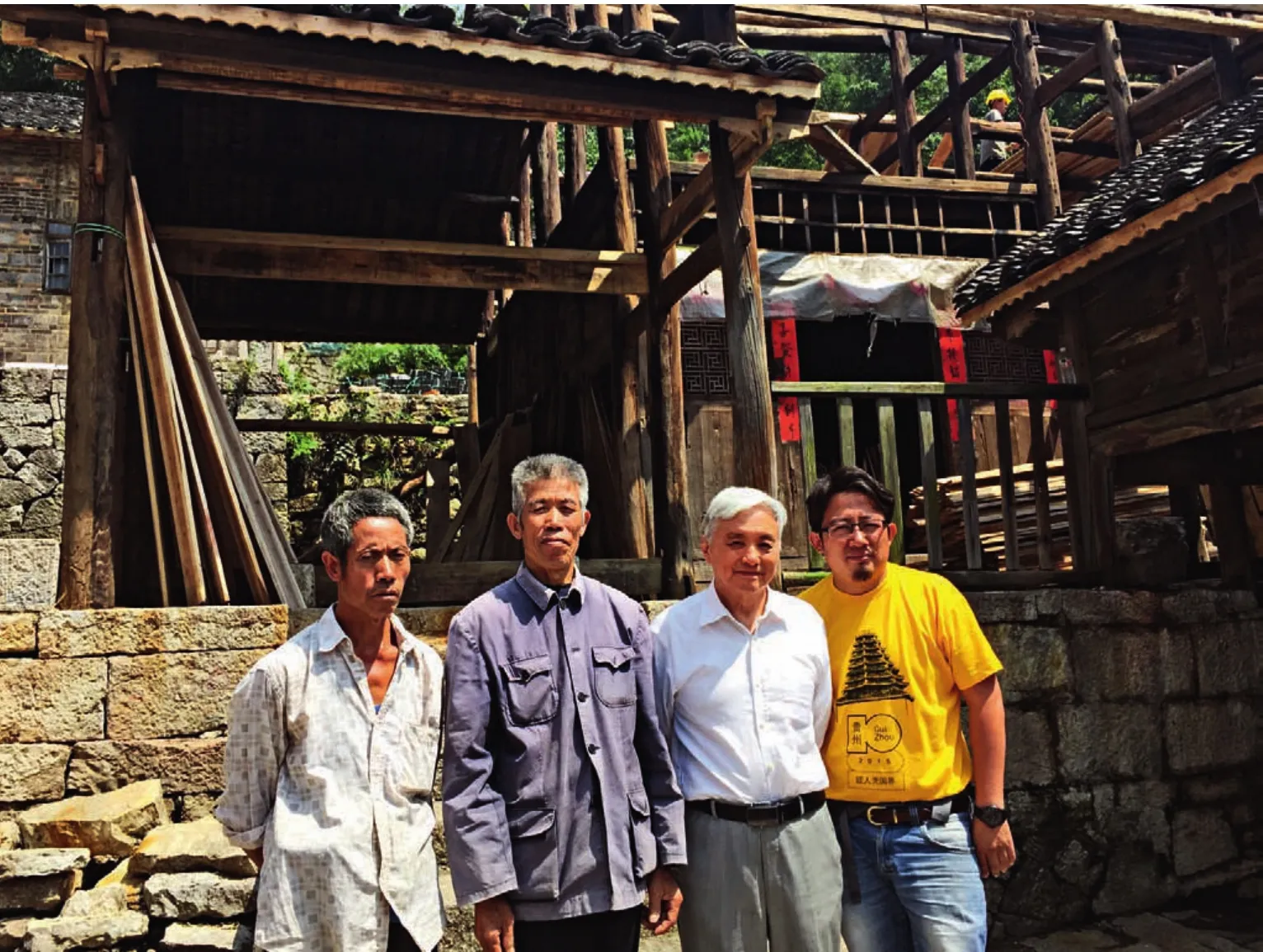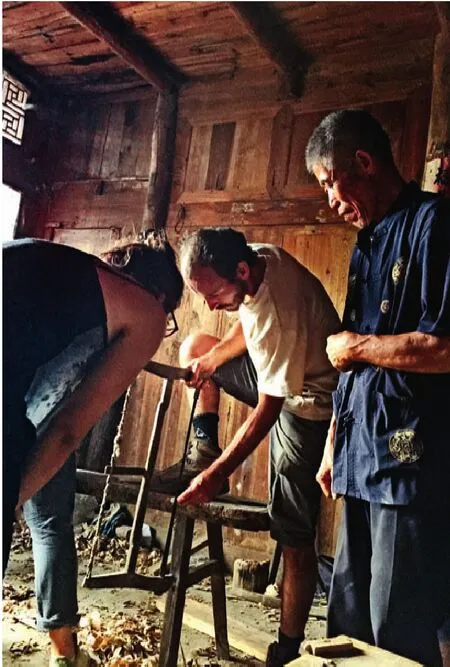guardianship of historical Sites grows
By staff reporter MA HUIYUAN
guardianship of historical Sites grows
By staff reporter MA HUIYUAN

Chinese and French volunteers restore the Wei clan ancestral hall in Guizhou Province. Yue Jian
L AST summer, a specialist restorative work camp descended on Guizhou Province’s Malang Village, where residents are mostly of the Bouyei ethnic group. Led by a French expert on architectural heritage protection and a Chinese architect, the group comprised six artisans and 10 French and 12 Chinese volunteers. Their mission in this venerable village was to restore the Wei clan ancestral hall, built more than 200 years ago from stone and timber. An embodiment of Chinese architectural excellence, the building constitutes a world architectural treasure.
Dedication
The work in Malang Village is part of an international collaboration project to protect heritage sites, co-organized by the Ruan Yisan Heritage Foundation, the French Union Rempart, and the Administrative Committee of Gui’an New District in Guizhou. Volunteers working on the project restore historical buildings using techniques and materials with which they were originally constructed.
Director of this work group Yue Jian represents the Ruan Yisan Heritage Foundation in Guizhou. He is also a council member of the World Association of Chinese Architects. Situated in Gui’an New District, Malang Village is home to 313 villagers in 86 households, 90 percent of whom are surnamed Wei. “The Wei clan ancestral hall, the first folk building in the village, was our main restoration task,” Yue said. The work of the French and Chinese volunteers was mainly cleaning up garbage, sorting materials, removing old tiles, trimming roofframes, laying new tiles, making wooden panes, carving stone foundations, and also studying embroidery skills. The restored house is to be transformed into a museum of historical everyday objects in the lives of local Bouyei people. It will be a cultural center in Malang Village, and photos of the restoration group at work will be among its exhibits.
French volunteer Emile Moriniere, a professional architect, has been taking part in such voluntary projects for 21 consecutive years, since he was 16 years old. “I appreciate the atmosphere in voluntary groups where participants are more concerned about contributing than expecting anything in return,” Emile said.
He first heard about the Malang restoration program in France, and joined the team there driven by his passion for heritage site protection and curiosity about China. He did mainly manual work in Malang, like carrying wood and removing garbage, and also learned fundamental carpentry skills. This was his first time in the Chinese countryside, and he admitted that he “had never realized there was such an immense gap between urban and rural areas in this country.”
In Emile’s opinion, big city residents tend to over-emphasize personal success, progress and wealth. And, according to his observations, when they visit the countryside, “urban people seem more shocked and incredulous even than a foreigner like me.” He added, “On the other hand, it is surprising to see the amount of large-scale land development going on in rural areas. There are broad highways illuminated by innumerable street lamps...this is far from my understanding of Eastern culture, and its emphasis on the harmonious coexistence of humans and nature.” But Emile found that this world view is still commonly held in Malang Village, although seldom encountered in France, even though hundreds of teams are working to preserve ancient buildings in his home country. “Chinese ancient constructions are elegant and rich in traditional cultural connotations. The edges and corners of these buildings are reminiscent of Chinese characters. But it’s a shame that some have not been regularly maintained, so giving an impression of desolation,” Emile said.
Chinese volunteer Su Chengfei is a student majoring in sociology at Nanjing University. She has always been interested in ancient wooden buildings, and the Malang project was her first practical experience in this field. Along with her French counterparts, Su carried bricks, sawed planks, and made mortises and tenons. “I hope that through our efforts villagers here might rediscover the value and beauty of their home,” Su said. “It is also a way of reviving China’s declining countryside.” Volunteer Chen Hongmei is a student at the School of History and Culture at Shandong University. “Having learned the theory from books, I joined the team to get practical experience of heritage protection,” Chen said, adding that she had learnt the most from bodily taking part in restoration works. “I believe our contributions have, to some extent, aroused locals’ awareness of the importance of preserving this site, and drawn attention to historical buildings.”
Chinese ancient constructions are elegant and rich in traditional cultural connotations. The edges and corners of these buildings are reminiscent of Chinese characters.

Learning from artisans is a way for volunteers to get practical experience outside school.Yue Jian
Wang Huiwen, a junior student majoring in architecture, took part in the Malang project out of interest in and concern about preserving historical constructions. “This kind of work is of huge educational significance to volunteers. Media coverage of it may also have positive impact on villagers, residents in neighboring areas, and the general public,” she said. Wang is thrilled to be learning how to make mortises and tenons. “I thought at first that it would be simple work. But I soon found that using a chisel requires concerted directional control and strength, and that the chisel must move according to the contours of the objects being carved, so it is not at all easy,” Wang said. “The depth and width of mortises determine the assembling of the panes. A window pane might appear simple in form, but each step of the work, from sawing the planks to assembling the frames, requires extreme care and patience.”
Volunteers in this group, whether French students or Chinese scholars and freelancers, are all under the spell of ancient Chinese architecture and at the same time dedicated to its preservation. Chinese volunteers said how deeply impressed they were with the vigor and proactiveness of their French fellow volunteers. Poor sanitary conditions and limited clean water in no way dampened their passion for restoration work.
Key Role of Education
The restoration in Malang Village is the fifth project of its kind in China. A few years ago, Professor Ruan Yisan of Shanghai’s Tongji University set up a foundation to protect heritage sites. Its first project was restoration work in the ancient city of Pingyao in Shanxi Province. Through Ruan’s efforts, historical towns and villages in China, including Dali, Fenghuang, Zhaohua, and Zhouzhuang, have been well preserved. UNESCO has honored Ruan with the Asia-Pacific Heritage Award. He has also received from France the Chevalier medal in the Order of Arts and Letters for his devotion to the conservation of heritage sites. Now in his 80s, the professor still works hard and travels far on his selfappointed mission.
Professor Ruan’s original intention in setting up the foundation was to popularize knowledge about ancient building protection. “Education plays the key role,” Ruan said. “Restored houses andwell-preserved sites are simply a drop in the ocean of China’s vast land. But people – our successors – are the most critical factor. We must encourage younger generations to discover the charm of ancient buildings. They are the main hope of this undertaking.” Though retired, the professor still gives classes, in the form of lectures at institutes and organizations involved in architecture protection. He also expects his foundation to contribute to raising public awareness and training inheritors in this field.

Yue Jian (first from right) and Professor Ruan Yisan (second from right) are devoted to protecting heritage sites. Wang Shilun
“Neither the government nor the university where I worked have given me any funding. I have done all fundraising for these projects and also contributed my own savings,” Ruan said. Research on historical constructions costs him almost RMB 200,000 each year. When Ruan Yisan and his team members carried out city planning for Pingyao he invited local officials to attend training programs at Tongji University, in hopes this would reveal to them the value of historical buildings. The professor took personal responsibility for all accommodation, tuition, and excursion expenses. In 1984 and 1985, he organized three such training programs, all highly successful. “However, we badly needed financial support from the public. In 2006, therefore, on the advice of my friends, I set up the heritage foundation in my name,” Ruan Yisan said. “It’s just one coin in the bucket, but I hope that through our activities more public attention will focus on safeguarding endangered architectural heritage.”
We must encourage younger generations to discover the charm of ancient buildings. They are the main hope of this undertaking.
When Pingyao ancient town was on the verge of demolition years ago, Professor Ruan led 12 of his students in carrying out planning to save the site. They cycled around the town, sketched the buildings, and developed themselves the photos they had taken. It is now a world famous tourist attraction. Thanks to their timely action, the thousand-yearold town was restored according to their research and can now be passed down to future generations.

French volunteer Emile Moriniere (middle) joins the team driven by his passion for heritage site preservation. Yue Jian
Room for Improvement
Increasingly more volunteers in China are joining Ruan’s team, so becoming one of the non-governmental forces in the field of cultural heritage protection.
The Chinese government has also issued various laws and regulations in this regard, including the Law of the People’s Republic of China on Protection of Cultural Relics in 1982, and the Regulation on the Protection of Famous Historical and Cultural Cities, Towns and Villages in 2008. As of June, 2014, 125 places had been ratified as famous historical and cultural cities.
In the meantime, local governments are becoming more aware of the significance of ancient sites protection in city planning and construction, and are learning from the experience of countries such as France.
Like China, France has a great number of time-honored monuments, around 40 of which are inscribed onthe UNESCO list of World Heritage. The French government spends more than €2 billion on the maintenance and restoration of ancient constructions. People in China are not yet fully aware of the importance of heritage protection, according to Emile Moriniere. “For example, we once discovered a cave that had formerly been used as a grain silo. But the local people’s first reaction was to fill it in rather than conserve it.”He went on, “In France, town planning and building give priority to conserving original materials and techniques. But in China, efficiency comes first – projects are expected to be completed as soon as possible.” He has found that the state of repair of historical sites in China varies dramatically. “For instance, some small temples are very well restored and maintained. But there is a chaotic ambience at other famous attractions due to overdeveloped tourism. I once visited a natural cave and discovered that it had more or less become a shelter for vendors. On the other hand, residents of some ancient villages have to leave their homes to make way for tourism. So I wonder if we develop tourism to enable better protection of such sites, or if we restore them solely for tourism’s sake.”
The Chinese volunteers in the team shared his opinion, saying that it is locals’ habitation of these residences that guarantees their practicability. Moreover, tourism cannot be recklessly developed and motivated solely by economic interests, as this has negative impact on historical sites. Professor Ruan Yisan observed that tourism and preservation are not contradictory. “But ‘memory’and ‘traditional techniques’ should come before economic benefits. Once lost, they can never be regained,” Ruan said.
Over thousands of years, Chinese architecture, as represented by wooden buildings, has always embodied the concept of “home” – a philosophy highly regarded by Chinese people. Hutong in Beijing, alleys in Shanghai, and tulou (earthen rural architecture) in Fujian represent family, neighborhood, and hometown values. There is in China today, as Professor Ruan advocates, greater awareness of heritage sites protection, evident in more efforts to restore them and so pass down the wisdom and culture of Chinese ancestors.

